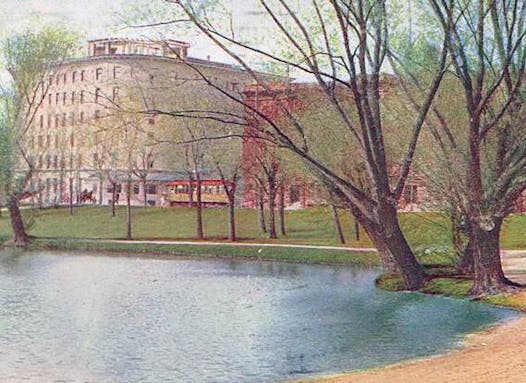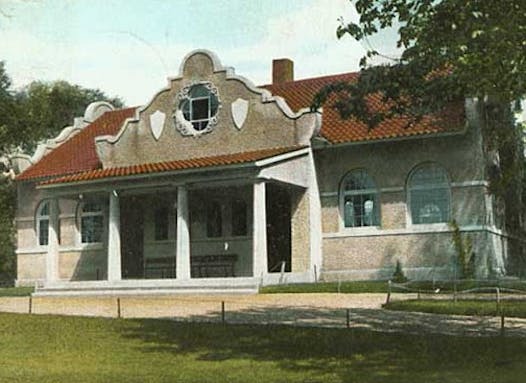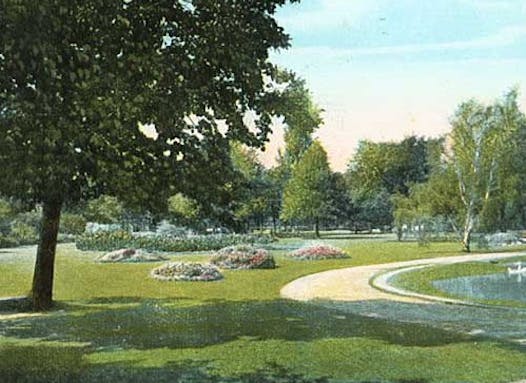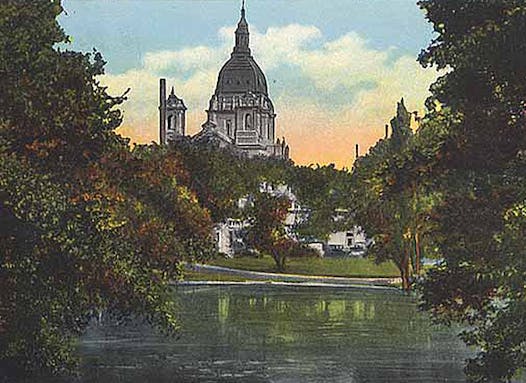Before the weather gets chilly, let's take a stroll around Loring Park. It's a nice amble — and it's also a history of the city written in miniature, full of details that bring back the names and changing fates of the city.
Who's Bob? Start with Berger Fountain, known colloquially as the Dandelion. (It would be great if they poured bright yellow dye into the water each summer, no?) It's really a memorial. To whom? Three guesses:
A) Australian World War II soldiers.
B) The Unknown Gentrifiers of the early '70s.
C) The park department's Fertilizer Procurement Division.
It's A. Ben Berger was a Minneapolis Park Board commissioner who saw sculptor Bob Woodward's El Alamein dandelion fountain on a trip to Australia and thought that one like it would look nice here. The base was designed by the architectural firm that included Jack Liebenberg, who designed the Uptown Theatre and scores of other buildings across Minnesota in collaboration with Seeman Kaplan.
Jewitt Park: Now head toward the statue on the hill to the north and consider the lives of the early settlers.
They noticed a deep footpath beaten by Indians traveling up from a Minnesota River settlement to St. Anthony Falls, but the area had no permanent encampments. The first white guy to settle, urged by his brother-in-law to leave Maine and come to Minnesota, went by the exotic name of Joseph Smith Johnson. He found a fellow named Dan Fife squatting on the land and paid him $500 to scoot. (What Fife did with the cash, no one knows, but you suspect a bender of epic proportions.) Johnson now owned the park and all the land to Franklin Avenue. He installed his family, and named the swampy pond Jewitt Lake after his wife's maiden name.
Johnson sold off the property over the years, and others moved into the park. There was a fellow named Harmon, for whom a street is named; streetcar magnate Tom Lowry built a big house on Groveland for his 16-year-old bride, and fabled moneybags J. Paul Getty grew up nearby in the early 1900s.
The Jewitt name didn't stick, and when it came time to declare the area the city's first big park in 1883, they went with ... Central. Soon afterward it was renamed Spring Grove Park, but everyone still called it Central until 1890, when it was renamed for Charles Loring, the city's first park commissioner.
The virtuoso: By now you're up on the hill by a statue of a man playing a violin. That's Ole Bull. He didn't live here. He didn't attend the 1895 dedication, but his son did — along with 1,200 men of the Norsemen's Singing Society who walked from Dania Hall on the West Bank for the ceremony. Ole Bull wasn't just the rock star of his day — he was a symbol of Norwegian culture. Installing his image in the park was a way of asserting national pride — 10 years before Norway would achieve independence.
Needs a plaque: The corner of Harmon Place and Maple Street is a parking lot now, but once there was a mansion. The Gale House cost $100,000 to build and was designed by Leroy Buffington, the Father of the Skyscraper. He was an impoverished father, though; he patented the iron-frame skyscraper, but only one person paid royalties: Rufus Rand, who build the Rand Tower. His family settled in Loring in the late 19th century, and perhaps he had fond memories of playing around the Gale House.
The Plaza: The Lyndale/Hennepin/I-94 gorge is a chasm that will forever keep Loring from connecting to the Sculpture Garden. The area was a mess when Lyndale and Hennepin crossed in an X — the infamous Scissors Intersection — but there was an old note of grace in the Plaza Hotel (1905). Imagine six stories of classically detailed limestone looking down on the park. It's been gone since the highway barreled through.
The Northwest Life Insurance Building: This was designed by Edwin Hewitt, a busy local architect whose name is rarely mentioned these days. He also built the long-lamented Metropolitan Bank building, the Northwestern Bell building (now Qwest), as well as the Methodist Cathedral on Loring, of which he was a member.
Another name of note in the area: Keg-o-ma-go-shieg, an Indian who made an annual trip to Loring to camp. According to Steve Trimble's history of Loring, "In the Shadow of the City," one researcher suggests that the name actually meant "don't have any sex with me." Or, as one might say today, "don't (bleep) with me."
Rock memorials: Continue toward the warming house, a gift of Charles Loring, and head up the stairs to a small field dotted with large stones. They have plaques, commemorating people and battles. One deserves scrutiny: It's dedicated to Maria Sanford. She was one of the nation's first female college educators and an advocate for women's rights, conservation and other causes of the early 20th century. Her statue is one of Minnesota's contributions to the National Statuary Hall Collection at the U.S. Capitol; this rock is her sole testament here.
That's about a tenth of the tales you can find here. Just don't be tempted to take a shortcut across the pond. The green gunk looks thick enough to support your weight, but I wouldn't try it.
James Lileks • 612-673-7858
Complex stories of migration are among the finalists for the Women's Prize for Fiction
Olympian Kristi Yamaguchi is 'tickled pink' to inspire a Barbie doll

After 4 decades in music and major vocal surgery, Jon Bon Jovi is optimistic and still rocking
Rom-com author Emily Henry knows the secret to having a healthy relationship with love






